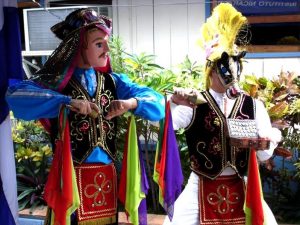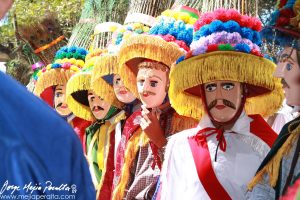El Güegüense is a Nicaraguan play about a trickster outwitting colonial authorities that comes from traditions of dance and street theater and is performed at the feast of San Sebastián every year in Diriamba.
Introduction
El Güegüense is a play closely tied to Nicaraguan identity and culture. The play holds a great deal of cultural significance with one author ever referring to it as, “The character of the Nicaraguan people” (Kotula), implying that it has been highly influential to the culture of that region. It is not only one of the most culturally significant examples of Nicaraguan theater but also one of the oldest. This play is also significant in that it deals with colonial themes, the central conflict revolving around a native Mestizo man who is under the jurisdiction of colonial laws and authorities who he manages to outwit through his superior knowledge of language. The play is performed annually at feast of San Sebastián, making it still relevant to Nicaraguan culture in the present day. El Güegüense is a historically and presently significant work of theater that remains integral to both the Nicaraguan and Mestizo identities (UNESCO).
History
El Güegüense is a play that has no known author, however it is estimated that the earliest written texts emerged around the late eighteenth century and it may possibly date back to the sixteen hundreds, making it the oldest known piece of Nicaraguan theater (Guevara, Aragón). Originally, the play was transmitted orally in Nahuatl, a native language primarily spoken in Southern Mexico and Central America. Throughout history, the text of El Güegüense has been commonly translated between Nahuatl and Spanish, making it accessible to both the natives and colonists of the era, as well as the modern Spanish speaking world (Diriamba.info).

Today however, the play is most notable for its usage each year in January at the feast of San Sebastián in Diriamba, Nicaragua. The performances at the feast of San Sebastián include the story itself accompanied by and interspersed with dance performances by non-professional groups. Additionally, the feast of San Sebastián receives national television coverage each year, making El Güegüense easily recognizable to most Nicaraguans. Even with this increased accessibility to the performance however, the play is declining in popularity due to the economic situation in Nicaragua as well as a diminished interest in performing (UNESCO).
Plot

The text of El Güegüense begins with the Spanish colonial governor declaring that no one can enter or leave the province without his permission. He makes this law in order to catch Güegüense, a traveling Mestizo merchant who had been evading taxes. Later, he sends his constable to retrieve Güegüense and confront him regarding his travel and taxes, however Güegüense tricks him, twisting his words and insulting him. Güegüense’s trickery continues and he convinces the governor to dance the racy “Macho Ratón,” which he ends up enjoying and thanking Güegüense for (Guevara). In the end, he manages not only to avoid punishment for tax evasion and traveling without a permit, but also manages to secure a marriage between his son and the governor’s daughter.
El Güegüense’s success is accomplished through his cleverness and trickery though ironically, in Nahuatl, Güegüense means “the honored elder,” despite the character’s deceptive and less than honorable ways. Many of Güegüense’s deceptions are accomplished through word play between Spanish and Nahuatl, as the character is bilingual. At many points in the text, the character feigns deafness, purposely misinterpreting words. When asked for coins or pesos duros as payment for his taxes, Güegüense mishears the request as as asking for quesos duros or hard cheese. Similar situations happen throughout the text as Güegüense utilizes his knowledge of language to purposely misinterpret conversations in order to get what he wants (Diriamba.info).
Significance

The text of El Güegüense has become so incredibly significant not due to specific details of the plot, but rather for the social implications that it has as well as its commentary on colonialism. El Güegüense’s role as a Mestizo man who tricks and gains the respect of the Spanish governor has become heavily associated with the national Mestizo identity and also makes the play an important piece of colonial literature. The protagonist is able to use the skill he has by being a part of both the Spanish and native cultures, namely his knowledge of both languages, in order to outwit a colonial authority. Additionally, the fact that the play was written in, and contains phrases from both Spanish and Nahuatl makes it an important blending of two cultures in a complex colonial relationship. Today, the vast majority of the Nicaraguan population is ethnically Mestizo, making the narrative of El Güegüense particularly appealing. The play encompasses both the Spanish and native aspects of their ethnic identities and analyzes how the blending of the cultures can be advantageous in many cases. Through El Güegüense’s wit, we are presented with a man closely tied to two cultures, something that is celebrated through the nationally broadcasted annual performance of El Güegüense at the feast of San Sebastián in Diriamba (Guevara).
Dance
El Güegüense is usually performed as street theater and contains a significant amount of dance both as part of the plot and in order to supplement the performance. The ballet of Güegüense is a dance performed as a diversion by Güegüense and his sons.
Following this ballet, the governor asks to see another, which he and his constable end up taking part in. Finally, the governor ends up requesting the dance “Macho Raton,” or the masquerade of the mules. These dances serve as both a break in dialogue to make the performance more colorful and, from a plot perspective, an opportunity for Güegüense to distract the governor and trick him into doing what he wants (Diriamba.info).
Conclusion
The play El Güegüense is highly significant to Nicaraguan and Mestizo culture. The incorporation of Spanish and Nahuatl as well as the portrayal of a bilingual and Mestizo protagonist, makes the play very highly representative of the blending of culture that is so integral to Nicaraguan identity. Today, we see this manifested in the annual performances at the feast of San Sebastián in Diriamba, Nicaragua, where the play remains a highly anticipated and well televised event. However, outside of the festival, El Güegüense is waning in popularity. Lack of economic stability and interest have led to a decrease in performances, despite the play’s clear association with national identity. The history and significance of El Güegüense makes it a work of theater that should be preserved, even in difficult times, as art is essential to cultural and national identity
Bibliography
Aragón, Alba. “Lessons in Güegüense.” Harvard University,
revista.drclas.harvard.edu/book/lessons-güegüense. Accessed 8 April 2018.
El Güegüense: o, Macho Ratón: drama épico-indígena. 2nd ed., Estrago, 2010.
“El Güegüense.” UNESCO: United Nations Educational, Scientific, and Cultural Organization,
ich.unesco.org/en/RL/el-gueguense-00111. Accessed 8 April 2018.
“Güegüense: A Masterpiece of the Oral and Intangible Heritage of Humanity” Diriamba.info,
2006, diriamba.info/English/elgueguense.htm. Accessed 8 April 2018.
Guevara, Alberto. “Re-enacting the nation: Unsettling Narratives in the El Güegüense Theatre of
Nicaragua.” Electronic Journal of Theory of Literature and Comparative Literature, 2,
62-78. http://www.452f. com/index.php/en/alberto-guevara.html. Accessed 8 April 2018.
Kotula, John. “Nicanotes: El Güegüense, The Character of the Nicaraguan People.” Alliance for
Global Justice, 2017, afgj.org/nicanotes-el-gueguense-character-nicaraguan-people.
Accessed 8 April 2018.
Images Cited
Mejía, Jorge. IMG_4230diri. 19 January 2009. Flickr, https://www.flickr.com/photos/mejiaperalta/3223125720.
Accessed 22 April 2018. CC BY-NC-SA 2.0. https://creativecommons.org/licenses/by/2.0/.
Mejía, Jorge. IMG_4376diri. 19 January 2009. Flickr, https://www.flickr.com/photos/mejiaperalta/3222266183.
Accessed 22 April 2018. CC BY-NC-SA 2.0. https://creativecommons.org/licenses/by/2.0/.
Pasionyanhelo, Representación de El Güegüense. 2010, May. Wikimedia Commons,
https://commons.wikimedia.org/wiki/File:El_Güegüense.jpg. Accessed 16 April 2018.
CC BY-NC-SA 2.0
Videos Cited
“Baile: El Güegüense – Diriamba, Carazo” Youtube, uploaded by Orgullo De Mi País, 23 October
2015, www.youtube.com/watch?v=pnLwsQUaYIQ.
“Gueguense Nicaragua.mp4” YouTube, uploaded by JC Martinez, 17 April 2010, https://www.youtube.com/watch?
v=H22R1Uz4bTo.
“Güegüense o Macho Ratón.” Youtube, uploaded by Ballet Folklórico Nicaraguense, 7
September 2011, www.youtube.com/watch?v=3fMTmYwvWKc.